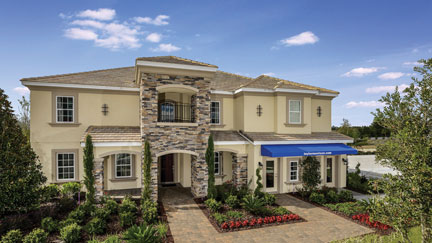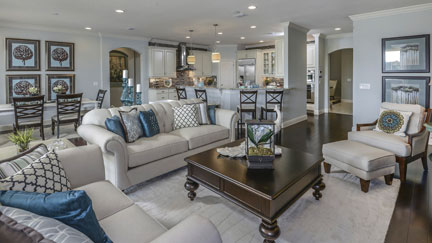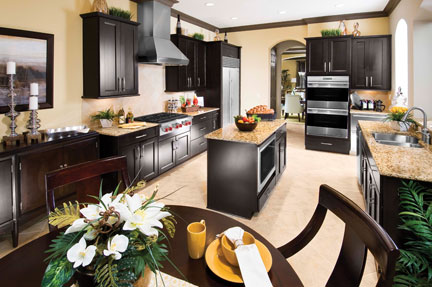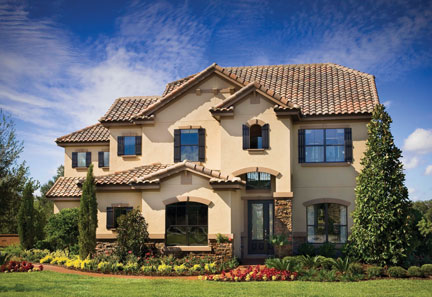
Living Large
 In the middle of the housing recession, most builders shrunk the size of their homes and industry pundits declared that McMansions were out and smaller “jewel box” homes were in.
In the middle of the housing recession, most builders shrunk the size of their homes and industry pundits declared that McMansions were out and smaller “jewel box” homes were in.
But even as average square footage declined to around 2,000, some contrarian builders went the other way, offering big-box homes with so many bedrooms that buyers lost track as they toured the models.
Because they were built on land bought cheaply from developers looking to unload heavily leveraged lots — and because interior finishes were kept relatively simple — these oversized structures could be sold at bargain prices, sometimes as little as $75 a square foot.
“There’s a high demand for large square footage for several reasons,” says Cara Kane, KB Home’s spokesperson. “One is the tremendous value per square foot. The buyer sees the benefits of getting a larger home for a minimal monthly payment difference.”
KB offers a 3,555-square-foot home with five to six bedrooms and a two-car garage in three Jacksonville-area communities: Westberry Manor, Whitmore Oaks and Glen St. Johns. The home — not surprisingly named the 3555 model — is priced starting at about $300,000.
For KB, the sale of homes 2,200 square feet or larger increased by more than 20 percent last year, Cane says. In Orlando, the company recently built a 4,278-square-foot showcase home that sold before it was even finished. Then it started a 3,787 square foot home that also sold before the paint was even dry.
The big home trend started in — wouldn’t you know it? —Texas, says Jeff Menzel, vice president of sales and marketing for Taylor Morrison’s North Florida division.

“We saw how big homes were becoming more and more popular,” says Menzel. “So we figured out how a Taylor Morrison home would look in that same type of product.” The result was its Grand and Estate collections, now offered in Jacksonville.
Taylor Morrison is building homes north of 5,000 square feet in its Las Calinas community in St. Augustine. Its Brantley model has six bedrooms, five bathrooms and a three-car garage in 5,073 square feet.
Buyers with large families and those encompassing multiple generations — including grandparents as well as children who boomeranged back home — are obvious potential big-home customers. But they aren’t the only ones.
“We had an active adult couple, with no children at home, and they bought one of our big Grand collection two-story homes,” says Menzel. “They just couldn’t get over what an amazing deal [per square foot] it was.’
Then there are buyers who just enjoy having extra room. For a small family the extra bedrooms often become studies so couples can each have their own office space as well as workout rooms and media rooms.
Many builders offer plans with the flexibility of having a master suite upstairs and/or downstairs. The downstairs master suite allows older buyers the option of minimizing stair climbing. And for the parents of teenagers, such a configuration offers some separation from their messy offspring. Upstairs master suites also allow parents with small children the convenience of being on the same level for nighttime care.
In Jacksonville, about 25 percent of the homes Taylor Morrison sells are bigger than 2,200 square feet. One of its most popular models is the two-story Beaumont, with 4,180 square feet, six bedrooms, three-and-a-half bathrooms and a three-car garage.
 Many buyers might worry that such large homes, even if they’re inexpensive to buy, will cost more to operate. However, today’s new homes are much more energy efficient than those built even 10 years ago. That means utilitiy bills are often no more in a new big home than they would be in an older small home, builders say.
Many buyers might worry that such large homes, even if they’re inexpensive to buy, will cost more to operate. However, today’s new homes are much more energy efficient than those built even 10 years ago. That means utilitiy bills are often no more in a new big home than they would be in an older small home, builders say.
Richmond American Homes has always built homes that average more than 3,000 square feet, says Doug Moran, the company’s Florida area president. Recently, however, its average home size has crept up closer to 4,000 square feet, he adds.
“The rates are still low and there’s such a high level of affordability that some people go for the value component and move from 3,000 to 4,000 square feet,” Moran says. One of the company’s bestselling models is the Magnolia, available in Forest Hammock at OakLeaf Plantation. The base model has 2,549 square feet, but upgrades include a fifth bedroom with an ensuite bathroom.
The demand for bigger homes has been so strong that Richmond American has expanded some of its plans into the 4,500 square foot range, with some topping 5,000 square feet.
David Weekley Homes has steadily ratcheted up the size of its homes as well, even in some smaller-lot communities. The company boosts living area and accommodates multigenerational households by adding “granny suites” to the back of some homes, typically apartments over the detached garage, says Steve Ebensberger, area vice president.
Jacksonville, Weekley offers designs larger than 4,000 square feet in Cross Creek and Greenleaf Village at Nocatee.
“We weren’t building larger homes before because there wasn’t the demand,” says Ebensberger. But, he adds, forces have aligned to make the market ripe for more square footage.
 Those forces include lower interest rates and higher resale value, which means sellers can get more for their existing homes and spend more for their new homes. “Families who have been on the sidelines for a number of years can get out of their homes again because they are not so upside-down,” Ebensberger says.
Those forces include lower interest rates and higher resale value, which means sellers can get more for their existing homes and spend more for their new homes. “Families who have been on the sidelines for a number of years can get out of their homes again because they are not so upside-down,” Ebensberger says.
And those buyers often want more than a lot of space in their homes. Many move-up buyers also want their homes more tricked out than the original no-frills, big-box products. Weekley, for example is known for outfitting its homes with bells and whistles that go well beyond basic.
“We’re seeing a number of bigger houses for a number of reasons,” says Barry Rutenberg of the Arthur Rutenberg franchise.
And it’s not just because larger homes can be a good value, he says.
In Jacksonville, Arthur Rutenberg franchisee Marcus Allen Homes offers many choices larger than 4,000 square feet in such communities as Glen Kernan, Pablo Creek Reserve, Palencia, Queens Harbor and The Plantation at Queens Harbor.
One of the company’s most popular models is the 3,587-square-foot Monaco, available in St Johns Forest, which offers an oversized open kitchen and an optional bonus room that some buyers are turning into “man caves” with billiard tables and oversized televisions.
“A number of people who are in the net-worth bracket that would normally buy larger homes are feeling more comfortable about the economy,” Rutenberg says. “Also, I think we’ve been coming out with new and better product, something that excites you about buying a new home.”
Standard Pacific Homes, another builder that has traditionally marketed to move-up buyers, has always built larger homes and hasn’t increased its average square footage by much. But, like Rutenberg, the company has reconfigured its plans to make better use of space, eliminating walls and adding huge windows along the back to bring the outside inside.
Newer models from Standard Pacific also feature huge kitchen islands, big pantries and “Costco” closets that cater to buyers’ desires for more storage space.
“You are getting even better design with homes that make better use of space,” says Danielle Tocco, Standard Pacific’s director for corporate communications.
Smarter buyers, too, who know a big bargain when they see one.
SIZE OF NEW HOMES CONTINUES TO EDGE UP
According to recently released data from the Survey of Construction, the trend toward smaller home sizes, which started during the market downturn, has since reversed itself.
In fact, since 2009, the median size of newly started single-family homes has increased steadily, to a record high of more than 2,300 square feet last year.
The survey is conducted by the U.S. Census Bureau, partly funded by HUD, and the source of the familiar monthly series on housing starts.
In addition to increased square footage, several other new-home characteristics have shown an upward trend from 2009 through 2012, the latest year for which figures are available.
For example, the average number of bathrooms in new single-family homes rose to a new high of 2.56 in 2012 following a period during which it edged down to as low as 2.20 in 2009.
The average number of bedrooms in newly started homes also declined during the downturn, but has since very gradually increased.
The pattern of temporary decline in home size during a downturn followed by recovery and resumption of an upward trend has happened before — the last time corresponding with the recession and recovery of the early 1980s.
Many experts thought that the decline in the 2000s was due to factors that would prove to be more permanent, such as desire to keep energy costs down.
Although many buyers are choosing smaller homes for a variety of reasons, energy efficient technology has advanced to the point where operation cost isn’t as dramatically impacted by square footage.
